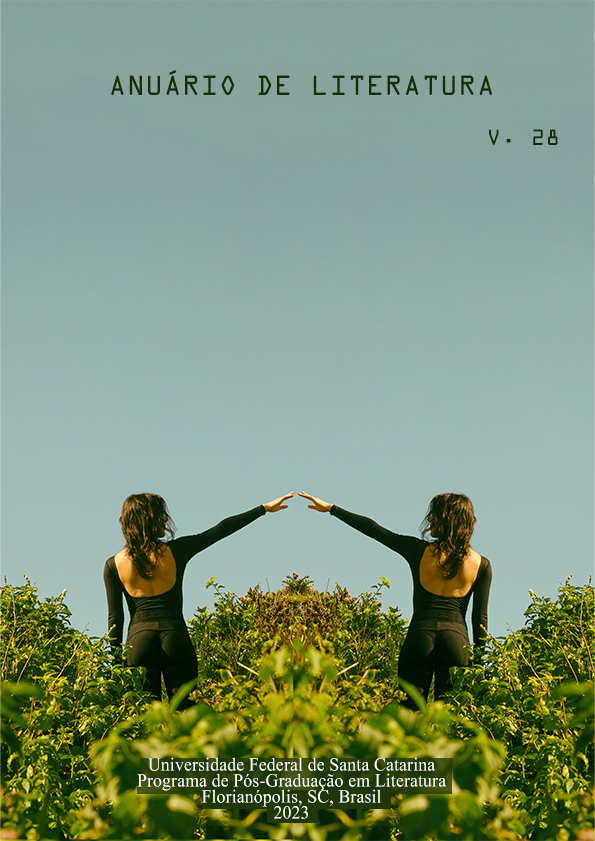Subalternity and silenced black women’s voices: an intersectional study in Ezilda Milanez Barreto
DOI:
https://doi.org/10.5007/2175-7917.2023.e95400Keywords:
Afro-Brazilian female characters, Silencing, Subalternities, DecolonialityAbstract
The visibility of the contributions of black subjects to the culture of our country is a conquered territory, considering that the unofficial historical narrative, erected by those in power (men, whites, cisheterosexuals, Christians, without disabilities), sought to erase the contribution of Africans and Afro-descendants to Brazilian culture or, given the impossibility of such erasure, allocated it to places of subordination, as we can see in many of the representations of black characters that circulated, especially in Brazilian nineteenth-century prose. Therefore, from the perspective of Intersectionality, the present article aims to analyze the black female characters, contextualized within the Brazilian patriarchy and related to the decoloniality of race, in the fiction of the Paraíba writer Ezilda Milanez Barreto, more specifically in the novels E a luz brilhará nas trevas (1940), Nos arcanos do império (1981) e O meu mundo é assim (1983). To base our positions on the concept of subalternity and silenced black voices, we rely on Spivak (2014), Crenshaw (1989) and Akotirene (2019). We hope to contribute to intersectional studies in Afro-Brazilian literature by female authors and to reflection on recurrent issues in Brazilian society, such as structural racism, which emerge from the diegesis of the narratives that constitute our corpus of analysis.
References
AKOTIRENE, Carla. Interseccionalidade. São Paulo: Pólen, 2019.
ARAÚJO, Ana Beatriz de Souza. Trabalho escravo contemporâneo: a invisibilidade seletiva das trabalhadoras domésticas e o caso paradigmático “madalena gordiano”. 2022. Monografia (Graduação em Direito) – Universidade Federal do Rio Grande do Norte. Natal, 2022.
BALISA, Fernanda Francisca; DAVID, Nismária Alves. A violência contra a mulher negra no conto “Maria”, de Conceição Evaristo. Litterata, Ilhéus, v. 7, n. 1, p. 72-82, jan./jun. 2017.
BARRETO, Ezilda Milanez. E a luz brilhará nas trevas. Areia: Livraria Santo Antônio, 1940.
BARRETO, Ezilda Milanez. À sombra da gameleira. Areia: 1961.
BARRETO, Ezilda Milanez. Nos arcanos do império. São Paulo: IBREX, 1981.
BARRETO, Ezilda Milanez. O meu mundo é assim. São Paulo: editora Soma. 1983.
BENTO, Berenice. Gênero: uma categoria útil de análise? Revista de História Comparada, n. 1, v. 16, p. 15-50, 2022. Disponível em: https://revistas.ufrj.br/index.php/RevistaHistoriaComparada/article/View/48966. Acesso em: 11 mar. 2023.
COLLINS, Patricia Hill; BILGE, Sirma. Interseccionalidade: a interseccionalidade para além da academia: a práxis crítica dos movimentos de mulheres. Trad. de Rane Souza. São Paulo: Boitempo, 2021.
CRENSHAW, Kimberle. Demarginalizing the Intersection of Race and Sex: A Black Feminist Critique of Antidiscrimination Doctrine, Feminist Theory and Antiracist Politics. University of Chicago Legal Fórum, n. 1, p. 139-167, 1989. Disponível em: https://chicagounbound.uchicago.edu/cgi/viewcontent.cgi?article=1052&context=uclf. Acesso em: 12 jun. 2022.
DAHIA, Sandra Leal de Melo. A mediação do riso na expressão e consolidação do racismo no Brasil. Sociedade e Estado, Brasília, v. 23, n. 3, p. 697-720, set./dez. 2008. Disponível em: https://www.scielo.br/j/se/a/4K46WkfCfTVQ8x9Fx6K3Cmn/?format=pdf&lang=pt. Acesso em: 31 ago. 2023.
DEIAB, Rafaela de Andrade. A mãe-preta na literatura brasileira: a ambiguidade como construção social (1880-1950). 2006. Dissertação (Mestrado em Antropologia) ? Faculdade de Filosofia, Letras e Ciências Humanas, Universidade de São Paulo. São Paulo, 2006.
FRANÇA, Jean M. Carvalho. Imagens do negro na literatura brasileira. São Paulo: Brasiliense, 1998.
NASCIMENTO, Letícia Carolina Pereira do. Transfeminismo. São Paulo: Jandaíra, 2021.
RIBEIRO, Djamila. O que é lugar de fala? Belo Horizonte: Letramento: Justificando, 2017.
RITT, Caroline Fockink. Uma análise necessária da mulher na sociedade brasileira e o reflexo na necessidade da representação da vítima para a punição do agressor da violência de gênero. Revista do Ministério Público do Rio Grande do Sul, n. 72, p. 79-114, maio 2012.
SALES, Ana Maria Coutinho. Ontem e hoje: mulheres romancistas no combate ao racismo. In: LIMA, Tania; NASCIMENTO, Izabel; OLIVEIRA, Andrey. Griots – culturas africanas: linguagem, memória, imaginário. Natal: Lucgraf, 2009, p. 19-29.
SILVEIRA, Ana Patrícia Frederico; FREITAS, Sávio Roberto Fonseca de. Nos arcanos do império, racismo e escrita de autoria feminina no romance de Ezilda Barreto. Interdisciplinar, São Cristóvão, UFS, v. 34, p. 101-118, jul-dez. 2020.
SPIVAK, Gayatri Chakravorty. Pode o subalterno falar? Trad. de Sandra Regina Goulart, Almeida, Marcos Pereira Feitosa, André Pereira Feitosa. Belo Horizonte: Editora UFMG, 2014.
Downloads
Published
How to Cite
Issue
Section
License
Copyright (c) 2023 Raimundo Mélo Neto Segundo, Marcelo Medeiros da Silva

This work is licensed under a Creative Commons Attribution 4.0 International License.
This journal provides open access to all of it content on the principle that making research freely available to the public supports a greater global exchange of knowledge. Such access is associated with increased readership and increased citation of an author's work. For more information on this approach, see the Public Knowledge Project, which has designed this system to improve the scholarly and public quality of research, and which freely distributes the journal system as well as other software to support the open access publishing of scholarly resources. The names and email addresses entered in this journal site will be used exclusively for the stated purposes of this journal and will not be made available for any other purpose or to any other party.

Este trabalho está licenciado com uma Licença Creative Commons - Atribuição 4.0 Internacional.


